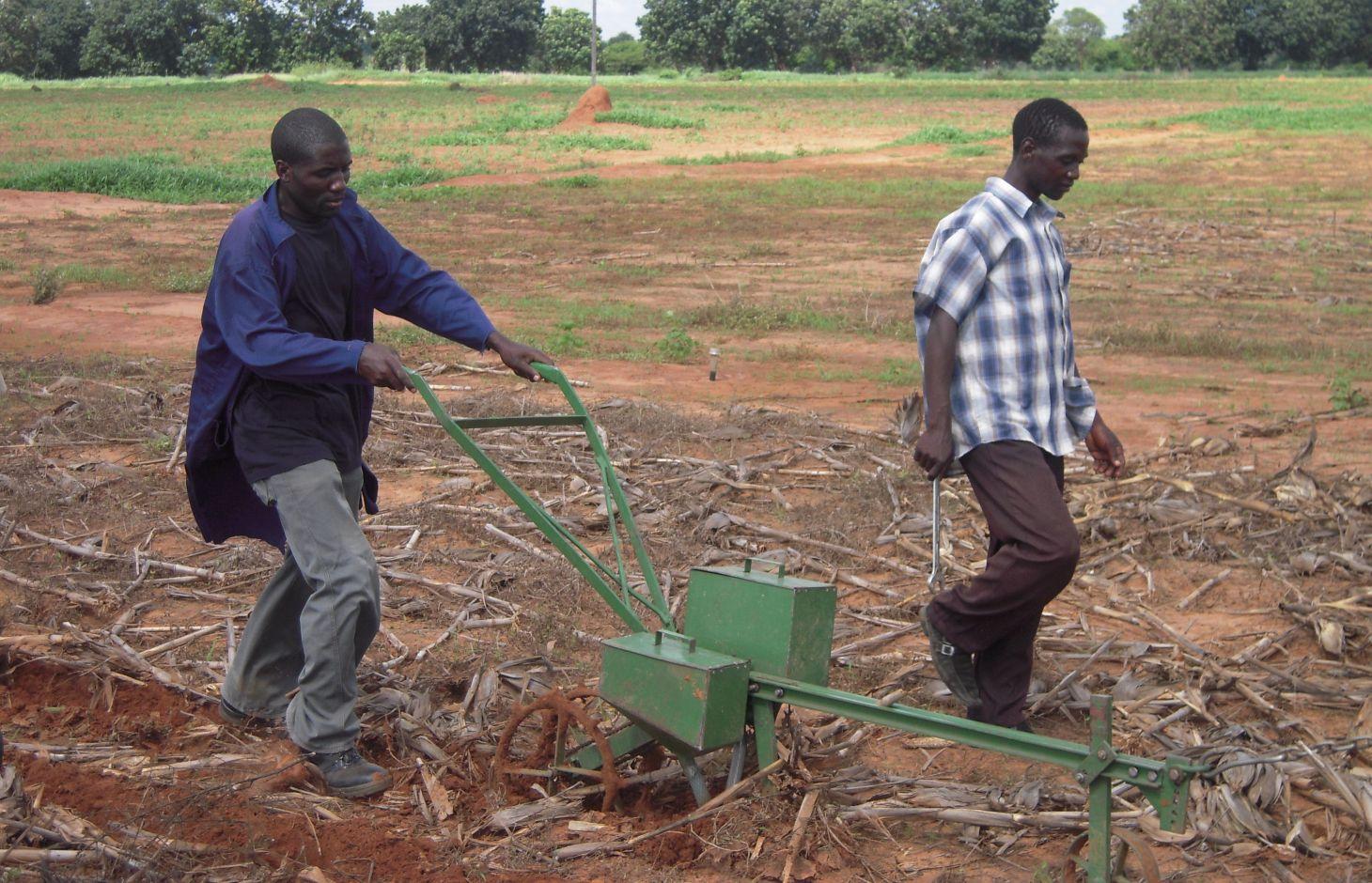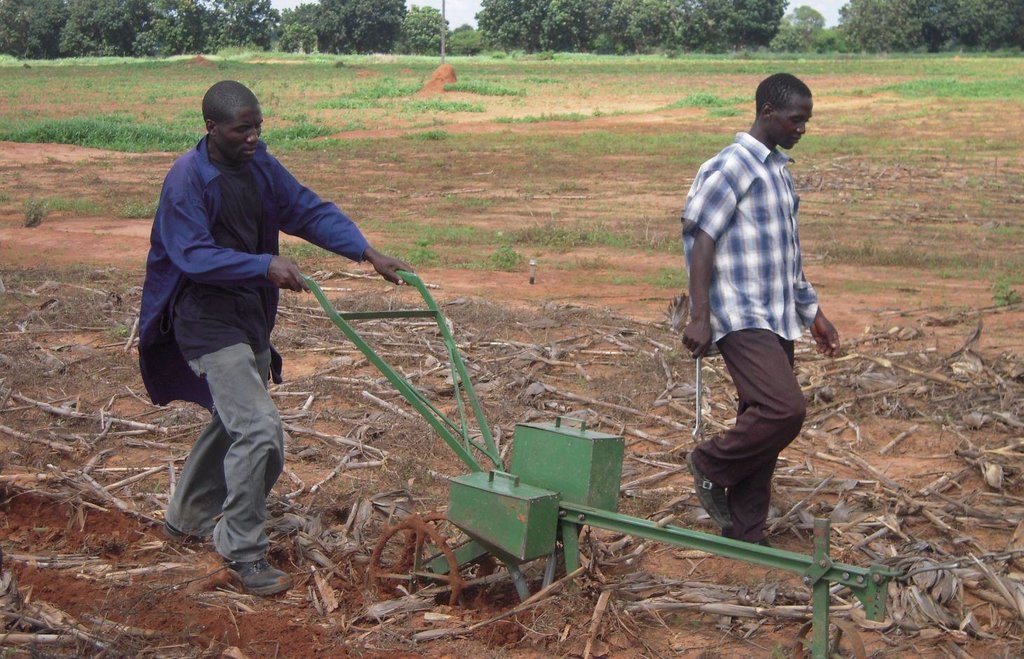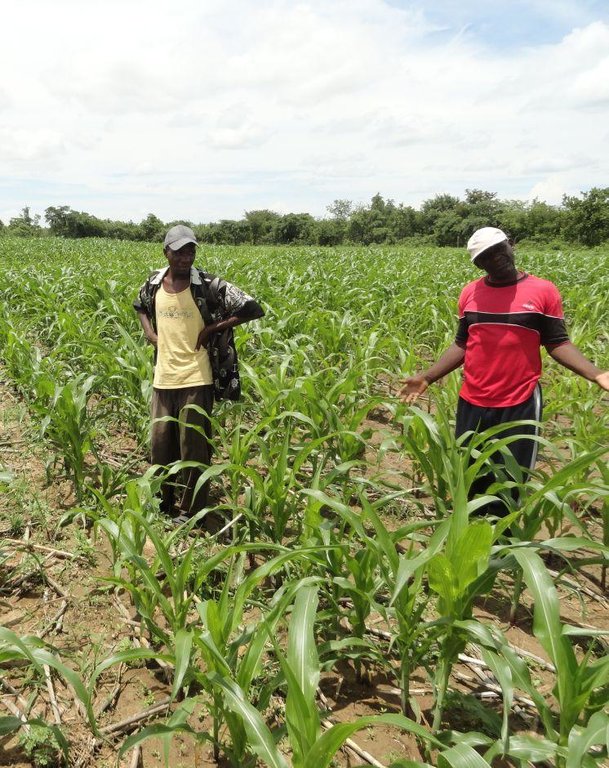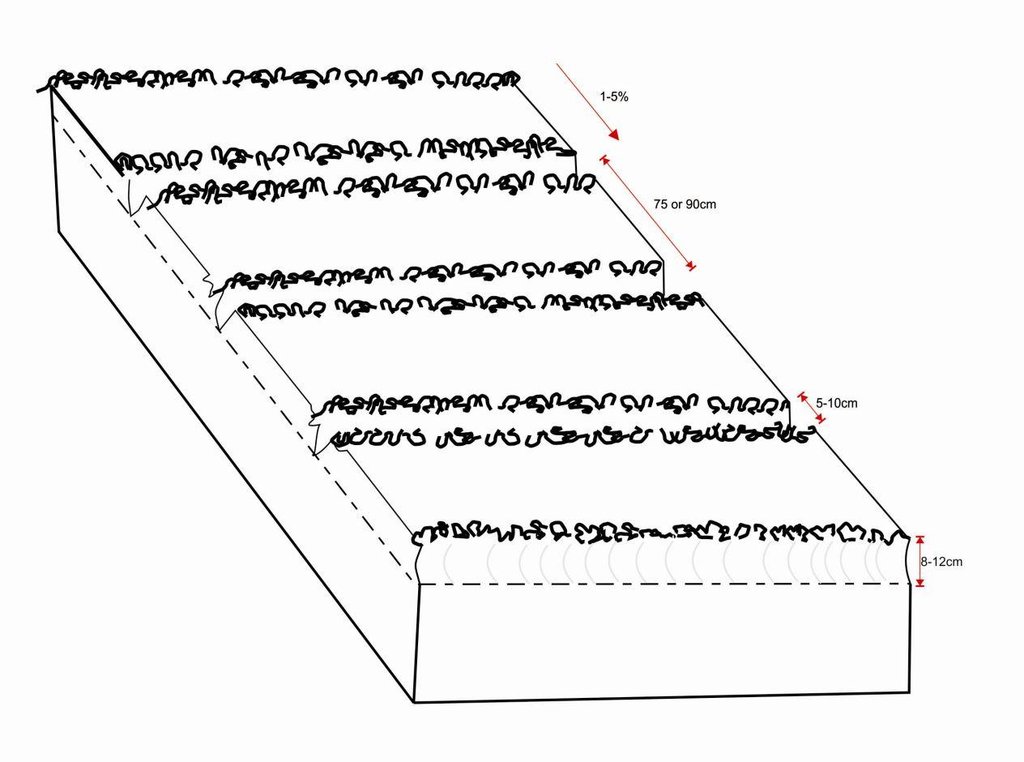Animal Draft Zero-Tillage [Zambia]
- Creación:
- Actualización:
- Compilador: Silenga Wamunyima
- Editor: –
- Revisores: Alexandra Gavilano, Fabian Ottiger
Direct Planting
technologies_1140 - Zambia
Visualizar secciones
Expandir todo Colapsar todos1. Información general
1.2 Detalles de contacto de las personas de referencia e instituciones involucradas en la evaluación y la documentación de la Tecnología
Especialista MST:
Katoweji Alfred
Golden Valley Agricultural Research Trust
Zambia
Especialista MST:
Ndandula Sharon
Golden Valley Agricultural Research Trust
Zambia
Nombre de la(s) institución(es) que facilitaron la documentación/ evaluación de la Tecnología (si fuera relevante)
Golden Valley agricultural research trust (Golden Valley agricultural research trust) - Zambia1.3 Condiciones referidas al uso de datos documentados mediante WOCAT
¿Cuándo se compilaron los datos (en el campo)?
15/01/2013
El compilador y la/s persona(s) de referencia claves aceptan las condiciones acerca del uso de los datos documentados mediante WOCAT:
Sí
1.5 Referencia al (los) Cuestionario(s) de Enfoques MST
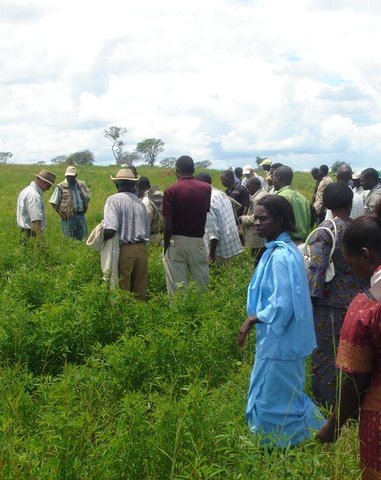
Participatory Research and Development [Zambia]
This is a collaborative process between researchers and farmers for developing and adapting new technologies that focus on incorporating the perspectives and inputs from the farmers into the development process.
- Compilador: Arthur Chomba
2. Descripción de la Tecnología MST
2.1 Breve descripción de la Tecnología
Definición de la Tecnología:
Animal draft zero-till involves the use of an animal drawn mechanical planter to plant directly in untilled soil to minimize soil disturbance and leave a cover of crop residues to conserve the soil and water.
2.2 Descripción detallada de la Tecnología
Descripción:
Zero-tillage takes advantage of the beneficial effects of biological processes to loosen the soil and to improve fertility. The organic matter from these processes aggregate the soil while the movement of soil organisms like worms and termites loosen the soil. This is called biological tillage and replaces mechanical tillage. The untilled soil surface covered by residues will require a planter specialized to plant in these conditions. In a sense, adopting zero-till does actually require a zero-till planter. The development of the strip-planter has made zero-till a viable option for animal draft farmers, which until now was not possible due to the unavailability or high cost of zero-till planters. The new planter is both cheap and easy to manufacture locally. The planter uses a narrow tine to open a planting furrow and seed/fertilizer is metered by vertically rotating plates. The planter is pulled by oxen and can plant rows of 75cm or 90cm rows with an intra-row which is determined by the seed plate used (3, 4, 5,…… seeds/m). The planting technology needs to be complemented with sound residue cover and weeding management practices.
Purpose of the Technology: The planter enables planting and fertilizing in untilled soil so that the soil residue cover and soil structure are preserved and can be used sustainably. The protective soil cover reduces evaporation and enhances infiltration while the improved soil structure and organic matter content increases soil water storage making zero tillage an important drought mitigating strategy. The immediate benefits of adopting zero-till are the possibility to plant a bigger area quickly and in time as well as the reduced soil erosion.
Establishment / maintenance activities and inputs: The first step in establishing zero-till is to assess the soil condition and levels of degradation. Where possible tests should be carried out but where not, the farmer needs to start on a small plot to check if there will be yield reduction from not tilling the soil. Where soils are severely degraded, an establishment phase should be embarked on where reduced tillage is practiced until the soil structure has recovered sufficiently to support crop growth without tillage. Liming acidic soils followed by a final ploughing will be required in the first year to correct the soil pH which otherwise will be difficult to correct once conservation tillage has been established. The organic matter levels need to be increased by increasing the amount of residues produced by the crop (i.e. the yields) and retaining these as soil cover. The next establishment activity is the purchase of the planter unit. Maintenance activities include planting and fertilizing in the same operation and weeding. Weeding will have to involve herbicide use to handle increased weed densities implying that spraying will become a major operation. In addition to the normal conventional inputs, herbicides will also become a major input and cost.
Natural / human environment: Zero-till has been applied in a wide range of bio-physical environments but mostly by the large scale farmers. The unavailability and high cost of specialized zero-till planter for small-scale farming has resulted in low adoption rates. The development of the Magoye Planter creates new opportunities for this practice. The farmer has to have sufficient knowledge to assess the soil condition and decide if is too degraded for zero-till or how long the transitional phase should be. Literacy is essential as the farmers will have to learn new approaches on weed control, pest control and crop rotations and adapt practices to suit his/her specific conditions.
2.3 Fotografías de la Tecnología
2.5 País/ región/ lugares donde la Tecnología fue aplicada y que se hallan comprendidos por esta evaluación
País:
Zambia
Región/ Estado/ Provincia:
Zambia/Southern Province
Especifique más el lugar :
Mazabuka/Magoye
Map
×2.6 Fecha de la implementación
Si no se conoce el año preciso, indique la fecha aproximada:
- hace menos de 10 años (recientemente)
2.7 Introducción de la Tecnología
Especifique cómo se introdujo la Tecnología:
- durante experimentos/ investigación
Comentarios (tipo de proyecto, etc.):
Development of the Magoye planter began in 2008 in response to farmers’ feedback on the Magoye Ripper. Farmers started adopting the technology in 2011
3. Clasificación de la Tecnología MST
3.2 Tipo(s) actuales de uso de la tierra donde se aplica la Tecnología

Tierras cultivadas
- Cosecha anual
Cosechas principales (comerciales y de subsistencia):
Annual cropping is the main source of livelihood.

Tierra de pastoreo
Tierras de pastoreo extensivo:
- Semi-nomadismo/ pastoralismo
Especies y productos animales principales:
Nearly half of the farmers own cattle but these are not sold regularly, only for school fees and ceremonies.
Livestock is grazing on crop residues
Comentarios:
Major land use problems (compiler’s opinion): Loss of soil structure and low soil fertility
Major land use problems (land users’ perception): Droughts and dry spell
3.3 Información adicional sobre el uso de tierras
Provisión de agua para la tierra donde se aplica la Tecnología:
- de secano
Número de temporadas de cultivo por año:
- 1
Especifique:
Longest growing period in days: 135Longest growing period from month to month: mid Nov to end of March
Densidad del ganado (si fuese relevante):
1-10 LU /km2
3.5 Difusión de la Tecnología
Comentarios:
Total area covered by the SLM Technology is 0.56 m2.
Zero-Till with the Magoye planter technology was introduced in 2011 and is only in its second season of use. Only four farmers have adopted the technology although it has not yet been officially launched and promoted.
3.6 Medidas MST que componen la Tecnología

medidas agronómicas
- A2: materia orgánica/ fertilidad del suelo
- A6: Otros
Comentarios:
Specification of other agronomic measures: Zero till, Crop residue
Type of agronomic measures: early planting, mulching, manure / compost / residues, mineral (inorganic) fertilizers, soil conditioners (lime, gypsum), zero tillage / no-till
3.7 Principales tipos de degradación de la tierra encarados con la Tecnología

erosión de suelos por agua
- Wt: pérdida de capa arable/ erosión de la superficie

deterioro químico del suelo
- Cn: reducción de la fertilidad y contenido reducido de la materia orgánica del suelo (no ocasionados por la erosión)

deterioro físico del suelo
- Pk: desmoronamiento y encostramiento

degradación biológica
- Bl: pérdida de la vida del suelo
Comentarios:
Main causes of degradation: soil management (Overploughing, soil nutrient mining), crop management (annual, perennial, tree/shrub) (Monocropping), overgrazing (Overgrazing of crop residues), poverty / wealth (Charcoal burning, under application of fertilizer), inputs and infrastructure: (roads, markets, distribution of water points, other, …) (high cost of fertilizer)
Secondary causes of degradation: deforestation / removal of natural vegetation (incl. forest fires) (Charcoal burning), Heavy / extreme rainfall (intensity/amounts) (Overgrazing of crop residues), droughts, land tenure (Communal land overexploited), education, access to knowledge and support services (inadequate extension staff), governance / institutional (lack of credit facilities)
3.8 Prevención, reducción o restauración de la degradación de la tierra
Especifique la meta de la Tecnología con relación a la degradación de la tierra:
- prevenir la degradación de la tierra
- reducir la degradación de la tierra
Comentarios:
Secondary goals: rehabilitation / reclamation of denuded land
4. Especificaciones técnicas, actividades de implementación, insumos y costos
4.1 Dibujo técnico de la Tecnología
4.2 Especificaciones técnicas/ explicaciones del dibujo técnico
Planting lines are done at a depth of 8-12cm with inter row of 75 or 90cm. The width of the open furrow is 5-10cm wide. Planting rows are done across the slope to reduce runoff, these planting rows are done when the soil is moist during the rainy season and planting is done at the same time with land preparation. Farmers in Monze have combined ripping and zero till together. In the dry season they rip with the Magoye Ripper or GART Planter and later when the soil is moist use a zero till implement to plant.
Location: Magoye. Mazabuka/Southern Province/Zambia
Date: 2014-06-29
Technical knowledge required for field staff / advisors: high (This is a new technology and the extension staff must be able to help farmers troubleshoot and adapt the technology to local conditions.)
Technical knowledge required for land users: moderate (The farmers have to adopt new soil management practices, crop rotations and adapt the weeding approaches to complement the planting technology)
Main technical functions: improvement of surface structure (crusting, sealing), improvement of topsoil structure (compaction), increase of infiltration, increase / maintain water stored in soil
Secondary technical functions: control of raindrop splash, improvement of ground cover, improvement of subsoil structure (hardpan), increase in organic matter, increase in nutrient availability (supply, recycling,…), increase of groundwater level / recharge of groundwater, water harvesting / increase water supply, improvement of water quality, buffering / filtering water
Early planting
Material/ species: maize
Quantity/ density: 44,000 pla
Remarks: 25cm intra row by 75cm
Mulching
Material/ species: crop residues
Quantity/ density: 3ton/ha
Remarks: uniformly spread
Manure / compost / residues
Material/ species: crop residues
Quantity/ density: 3ton/ha
Remarks: uniformly spread
Mineral (inorganic) fertilizers
Material/ species: basal and top dressing
Quantity/ density: 400kg/ha
Remarks: spot application
Soil conditioners (lime, gypsum)
Material/ species: lime
Quantity/ density: 1ton/ha
Remarks: broadcast
4.3 Información general sobre el cálculo de insumos y costos
otra / moneda nacional (especifique):
Kwacha
Indique la tasa de cambio de USD a la moneda local (si fuese relevante): 1 USD =:
5,0
Indique el costo promedio del salario de trabajo contratado por día:
2.40
4.4 Actividades de establecimiento
| Actividad | Tipo de medida | Momento | |
|---|---|---|---|
| 1. | Purchase a magoye planter | Agronómicas | |
| 2. | Purchase a knapsack sprayer | Agronómicas |
Comentarios:
Life span of the magoye planter: 15 years
Life span of the knapsack sprayer: 5 years
4.5 Costos e insumos necesarios para el establecimiento
| Especifique insumo | Unidad | Cantidad | Costos por unidad | Costos totales por insumo | % de los costos cubiertos por los usuarios de las tierras | |
|---|---|---|---|---|---|---|
| Equipo | Magoye Planter | piece | 1,0 | 500,0 | 500,0 | 100,0 |
| Equipo | Knapsack sprayer | piece | 1,0 | 80,0 | 80,0 | 100,0 |
| Costos totales para establecer la Tecnología | 580,0 | |||||
Comentarios:
Duration of establishment phase: 2 month(s)
4.6 Actividades de establecimiento/ recurrentes
| Actividad | Tipo de medida | Momento/ frequencia | |
|---|---|---|---|
| 1. | Slashing, spreading residues | Agronómicas | May-June every year after harvest |
| 2. | Liming | Agronómicas | Nov - Dec every 3years |
| 3. | Planting and fertilizing | Agronómicas | Nov-Dec at onset of rain |
| 4. | Chemical weeding | Agronómicas | 3 times per growing season |
| 5. | Harvesting | Agronómicas | May-June |
4.7 Costos e insumos necesarios para actividades de mantenimiento/ recurrentes (por año)
| Especifique insumo | Unidad | Cantidad | Costos por unidad | Costos totales por insumo | % de los costos cubiertos por los usuarios de las tierras | |
|---|---|---|---|---|---|---|
| Mano de obra | Slashing, spreading residues | person days | 8,0 | 2,5 | 20,0 | 100,0 |
| Mano de obra | Liming | person days | 2,0 | 2,5 | 5,0 | 100,0 |
| Mano de obra | Chemical weeding | person days | 24,0 | 1,0 | 24,0 | 100,0 |
| Mano de obra | Harvesting | person days | 8,0 | 2,5 | 20,0 | 100,0 |
| Equipo | Animal traction for planting and fertilizing | ha | 1,0 | 40,0 | 40,0 | 100,0 |
| Material para plantas | Seeds | kg | 20,0 | 2,5 | 50,0 | 100,0 |
| Material para plantas | Fertilizer | kg | 400,0 | 0,8 | 320,0 | 100,0 |
| Material para plantas | Herbicides | l | 5,0 | 6,0 | 30,0 | 100,0 |
| Material para plantas | Lime | ton | 1,0 | 42,0 | 42,0 | 100,0 |
| Indique los costos totales para mantenecer la Tecnología | 551,0 | |||||
Comentarios:
Machinery/ tools: The Magoye planter
Calculation are for 1ha of maize under strip tillage based conservation tillage and costs are for the Zambia situation in Magoye as of August 2012.
4.8 Factores más determinantes que afectan los costos:
Describa los factores más determinantes que afectan los costos:
The weed control method is the main determinate factor depending on whether the farmer uses hand hoe or herbicides. Weed densities are higher in unploughed fields increasing the labour requirements/costs by a factor of about 5 if hand weeding is used instead of herbicides. Another major cost is that of fertilizer which makes up about half the cost hence the total cost will vary significantly depending on fertilizer cost.
5. Entorno natural y humano
5.1 Clima
Lluvia anual
- < 250 mm
- 251-500 mm
- 501-750 mm
- 751-1,000 mm
- 1,001-1,500 mm
- 1,501-2,000 mm
- 2,001-3,000 mm
- 3,001-4,000 mm
- > 4,000 mm
Zona agroclimática
- semi-árida
Thermal climate class: subtropics. 3 distinct seasons – summer, winter and one rainy season
5.2 Topografía
Pendientes en promedio:
- plana (0-2 %)
- ligera (3-5%)
- moderada (6-10%)
- ondulada (11-15%)
- accidentada (16-30%)
- empinada (31-60%)
- muy empinada (>60%)
Formaciones telúricas:
- meseta/ planicies
- cordilleras
- laderas montañosas
- laderas de cerro
- pies de monte
- fondo del valle
Zona altitudinal:
- 0-100 m s.n.m.
- 101-500 m s.n.m.
- 501-1,000 m s.n.m
- 1,001-1,500 m s.n.m
- 1,501-2,000 m s.n.m
- 2,001-2,500 m s.n.m
- 2,501-3,000 m s.n.m
- 3,001-4,000 m s.n.m
- > 4,000 m s.n.m
5.3 Suelos
Profundidad promedio del suelo:
- muy superficial (0-20 cm)
- superficial (21-50 cm)
- moderadamente profunda (51-80 cm)
- profunda (81-120 cm)
- muy profunda (>120 cm)
Textura del suelo (capa arable):
- mediana (limosa)
- fina/ pesada (arcilla)
Materia orgánica de capa arable:
- baja (<1%)
5.4 Disponibilidad y calidad de agua
Agua subterránea:
> 50 m
Disponibilidad de aguas superficiales:
mediana
Calidad de agua (sin tratar):
agua potable de mala calidad (requiere tratamiento)
5.6 Las características de los usuarios de la tierra que aplican la Tecnología
Ingresos no agrarios:
- 10-50% de todo el ingreso
Nivel relativo de riqueza:
- muy pobre
- pobre
Individuos o grupos:
- individual/ doméstico
Género:
- hombres
Indique otras características relevantes de los usuarios de las tierras:
Land users applying the Technology are mainly common / average land users
Difference in the involvement of women and men: The technology is applied mostly by men since most households are male headed and animal traction operation are reserved for men
Population density: 10-50 persons/km2
Annual population growth: 3% - 4%
8% of the land users are rich and own 15% of the land (own more than 10 cattle).
8% of the land users are average wealthy and own 15% of the land (own between 5 and 10 cattle).
16% of the land users are poor and own 20% of the land (own less than 5 cattle).
68% of the land users are poor and own 40% of the land (do not own cattle).
Off-farm income specification: sale of rainfed crops makes up about half of their income, the remainder coming from sale of livestock, petty trading, hiring out labour and remittances
Market orientation of production system: subsistence (self-supply), subsistence (self-supply), mixed (subsistence/ commercial
5.7 Área promedio de la tierra que pertenece a o es arrendada por usuarios de tierra que aplican la Tecnología
- < 0.5 ha
- 0.5-1 ha
- 1-2 ha
- 2-5 ha
- 5-15 ha
- 15-50 ha
- 50-100 ha
- 100-500 ha
- 500-1,000 ha
- 1,000-10,000 ha
- > 10,000 ha
¿Esto se considera de pequeña, mediana o gran escala (refiriéndose al contexto local)?
- pequeña escala
Comentarios:
Average area of land owned or leased by land users applying the Technology: 1-2 ha, 2-5 ha, 5-15 ha, 5-15 ha, 15-50 ha, 15-50 ha, 50-100 ha
5.8 Tenencia de tierra, uso de tierra y derechos de uso de agua
Tenencia de tierra:
- individual, sin título
Derechos de uso de tierra:
- acceso abierto (no organizado)
- individual
- Land is apportioned by traditional leaders
Derechos de uso de agua:
- acceso abierto (no organizado)
- Land is apportioned by traditional leaders
5.9 Acceso a servicios e infraestructura
salud:
- pobre
- moderado
- bueno
educación:
- pobre
- moderado
- bueno
asistencia técnica:
- pobre
- moderado
- bueno
empleo (ej. fuera de la granja):
- pobre
- moderado
- bueno
mercados:
- pobre
- moderado
- bueno
energía:
- pobre
- moderado
- bueno
caminos y transporte:
- pobre
- moderado
- bueno
agua potable y saneamiento:
- pobre
- moderado
- bueno
servicios financieros:
- pobre
- moderado
- bueno
6. Impactos y comentarios para concluir
6.1 Impactos in situ demostrados por la Tecnología
Impactos socioeconómicos
Producción
producción de cultivo
producción de forraje
riesgo de fracaso de producción
área de producción
Cantidad antes de MST:
2-3ha
Cantidad luego de MST:
>10
Ingreso y costos
ingreso agrario
diversidad de fuentes de ingreso
carga de trabajo
Impactos socioculturales
oportunidades recreativas
Impactos ecológicos
Ciclo de agua/ escurrimiento de sedimento
calidad de agua
cosecha/ recolección de agua
escurrimiento superficial
evaporación
Suelo
humedad del suelo
cubierta del suelo
pérdida de suelo
encostramiento/ sellado de suelo
compactación de suelo
ciclo/ recarga de nutrientes
salinidad
materia orgánica debajo del suelo C
Biodiversidad: vegetación, animales
biomasa/ sobre suelo C
Reducción de riesgos de desastres y riesgos climáticos
emisión de carbono y gases de invernadero
6.2 Impactos fuera del sitio demostrados por la Tecnología
disponibilidad de agua
inundaciones río abajo
contaminación de aguas subterráneas/ de ríos
daño a campos de vecinos
6.3 Exposición y sensibilidad de la Tecnología al cambio climático gradual y a extremos relacionados al clima/ desastres (desde la percepción de los usuarios de tierras)
Cambio climático gradual
Cambio climático gradual
| Estación | tipo de cambios climáticos/ climas extremos | ¿Cómo es que la tecnología soporta esto? | |
|---|---|---|---|
| temperatura anual | incrementó | no se sabe |
Extremos (desastres) relacionados al clima
Desastres climatológicos:
| ¿Cómo es que la tecnología soporta esto? | |
|---|---|
| tormenta de lluvia local | bien |
| tormenta de viento | no se sabe |
Desastres climatológicos
| ¿Cómo es que la tecnología soporta esto? | |
|---|---|
| sequía | bien |
Desastres hidrológicos
| ¿Cómo es que la tecnología soporta esto? | |
|---|---|
| inundación general (río) | no muy bien |
Otras consecuencias relacionadas al clima
Otras consecuencias relacionadas al clima
| ¿Cómo es que la tecnología soporta esto? | |
|---|---|
| periodo reducido de crecimiento | bien |
6.4 Análisis costo-beneficio
¿Cómo se comparan los beneficios con los costos de establecimiento (desde la perspectiva de los usuarios de tierra)?
Ingresos a corto plazo:
positivo
Ingresos a largo plazo:
muy positivo
¿Cómo se comparan los beneficios con los costos de mantenimiento/ recurrentes (desde la perspectiva de los usuarios de tierra)?
Ingresos a corto plazo:
positivo
Ingresos a largo plazo:
muy positivo
Comentarios:
Timely and quicker planting enables larger areas to be planted and with less labour in the short term. Improved soil structure and soil fertility leads to higher yields and better resilience to droughts in the long term
6.5 Adopción de la Tecnología
- casos individuales / experimentales
De todos quienes adoptaron la Tecnología, ¿cuántos lo hicieron espontáneamente, es decir, sin recibir incentivos/ pagos materiales?
- 0-10%
Comentarios:
4 land user families have adopted the Technology without any external material support
Comments on spontaneous adoption: The Magoye planter has not yet been officially launched or promoted and the farmers currently using the technology heard of it by word of mouth and insisted on purchasing
There is a strong trend towards spontaneous adoption of the Technology
There has been numerous inquiries to purchase the Magoye planter even before it can be promoted
6.7 Fuerzas/ ventajas/ oportunidades de la Tecnología
| Fuerzas/ ventajas/ oportunidades desde la perspectiva del usuario de la tierra |
|---|
|
Enables early planting How can they be sustained / enhanced? Plant in with the first rain |
|
Quicker planting enables the planting of larger areas How can they be sustained / enhanced? Plant the seed and fertilize in one operation |
|
reduced workload How can they be sustained / enhanced? Encourage minimum tillage |
| Fuerzas/ ventajas/ oportunidades desde la perspectiva del compilador o de otra persona de referencia clave |
|---|
|
Enables early planting How can they be sustained / enhanced? Plant in November with the first heavy rain |
|
Quicker planting enables the planting of larger areas How can they be sustained / enhanced? Use herbicides because without them, the capacity to weed will limit the production capacity |
|
Preserves soil cover and reduces soil disturbance How can they be sustained / enhanced? Training in residue management and zero till |
6.8 Debilidades/ desventajas/ riesgos de la Tecnología y formas de sobreponerse a ellos
| Debilidades/ desventajas/ riesgos desde la perspectiva del usuario de la tierra | ¿Cómo sobreponerse a ellas? |
|---|---|
| The purchase price of the Magoye planter is quite high | Subsidize the implement |
| Excessive weeds and lack of information on herbicide use | More training on herbicide use |
| Debilidades/ desventajas/ riesgos desde la perspectiva del compilador o de otra persona de referencia clave | ¿Cómo sobreponerse a ellas? |
|---|---|
| The purchase price for the planter is on the higher side making it affordable only to the larger small-scale farmers | the price is likely to go down when the planter is mass produced |
| difficult to control weeds in the absence of herbicides | use herbicides |
7. Referencias y vínculos
7.2 Vínculos a las publicaciones disponibles
Título, autor, año, ISBN:
Social-economic analysis of conservation agriculture in southern Africa, FAO, 2011
¿Dónde se halla disponible? ¿Costo?
FAO
Título, autor, año, ISBN:
Conservation farming in Zambia, Steven Haggblade, Gelson Tembo, October 2003
¿Dónde se halla disponible? ¿Costo?
Indaba project, Michigan state university
Título, autor, año, ISBN:
Conservation farming in Zambia, Conservation farming unit (CFU), 2011
¿Dónde se halla disponible? ¿Costo?
cfu@zamnet.zm
Vínculos y módulos
Expandir todo Colapsar todosVínculos

Participatory Research and Development [Zambia]
This is a collaborative process between researchers and farmers for developing and adapting new technologies that focus on incorporating the perspectives and inputs from the farmers into the development process.
- Compilador: Arthur Chomba
Módulos
No se hallaron módulos


